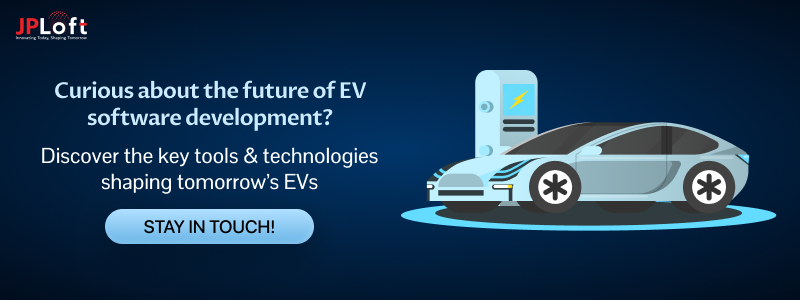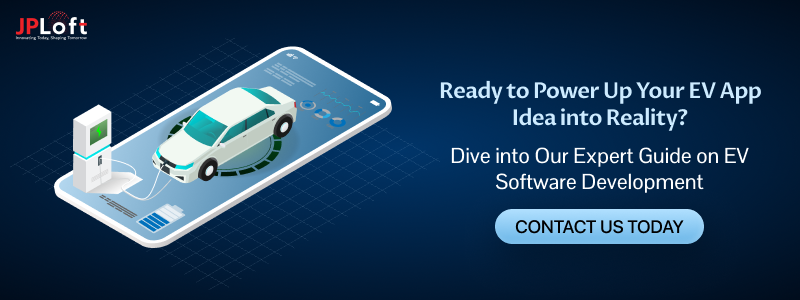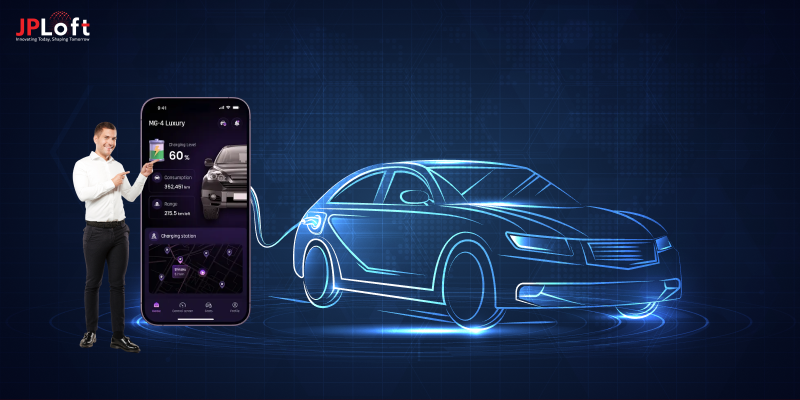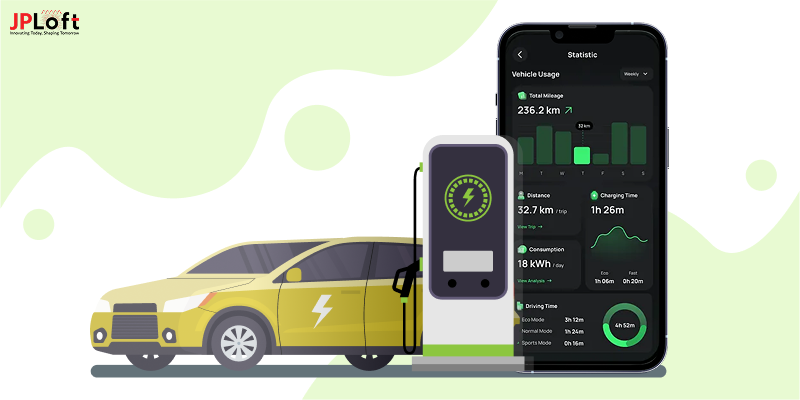Elon Musk quotes “You can't stop the advent of electric cars”- EV success is as inevitable as cars replacing horses.
That’s not just a prediction, it’s a movement already in motion.
The world isn’t just switching gears; it’s rewriting the blueprint of transportation and at the core of this transformation lies electric vehicle software development.
With ambitious goals for EV adoption and a rapidly expanding charging infrastructure, North Carolina alone aims to have at least 1.25 million zero-emission vehicles registered by 2030.
So, whether you’re a tech enthusiast, a developer, or just EV-curious, this guide will steer you through the dynamic, high-voltage world of electric vehicle software and app development. Let’s explore it.
Inside the Mind of an EV: Understanding Software Development
An EV runs on intelligence, and its software is the true driving force. Without it, even the most advanced model is just a shell. Here's what makes EV software development so essential:
- EV software acts as the brain, constantly processing data and making real-time decisions to ensure optimal performance.
- Core software systems include the Vehicle Control Unit (VCU), Battery Management System (BMS), and infotainment. These must be robust, responsive, and scalable.
- Mobile-first experiences are now essential. EV mobile apps allow users to monitor battery health, control climate remotely, find charging stations, schedule smart charging, and get OTA updates.
- Success in EV software lies in combining embedded systems with mobile solutions, powered by real-time data, cloud integration, intuitive UX, and regulatory compliance.
In short, electric vehicle mobile app development is no longer optional, it’s an essential part of delivering a connected EV experience.
The electric vehicle revolution is already here as market statistics clearly show it.
Let’s take a glance at it.
Market Statistics of Electric Vehicle Software
Most of us questioned “How to develop an EV software?” But before jumping into the development section, it is crucial to know the market statistics to fulfil customers’ demand.
-
According to Allied Market Research, in 2023, the global EV charging software market was valued at $1.1 billion, and it's projected to grow significantly, reaching $11.1 billion by 2032, with a strong CAGR of 28.9% between 2024 and 2032.
-
A study by Global Market Insights shows that the global EV charging management software platform market was valued at $2.8 billion in 2024 and is expected to grow at a CAGR of 23.1% from 2025 to 2034.
-
Over 60% of EV users engage with their vehicles via mobile apps, positioning EV app development as a major business opportunity.
-
Statista reported, the global electric vehicles market is projected to generate an impressive revenue of $784.2 billion in 2025.
-
Based on data from Introspective Market Research, the electric vehicle software market was valued at $312.37 billion in 2024 and is expected to reach $1,119.58 billion by 2032, growing at a CAGR of 17.30% from 2025 to 2032.
So, if you're planning to create an app for electric vehicles, understanding these trends and market demands will give you a powerful head start.
Types of EV Software You Should Know
Electric vehicles rely on a powerful network of software systems that work together to deliver a seamless driving experience.
Each system plays a unique role in making electric vehicles smarter, safer, and more user-friendly. And if you're wondering how to build an EV software that delivers such performance, it all starts with understanding these core components:
A] Navigation Software
Helps EV drivers plan efficient routes, avoid traffic, and locate charging stations with precision. This software often integrates with real-time GPS, traffic data, and range-aware routing algorithms to reduce range anxiety.
B] Anti-Theft Software
Security is critical in connected vehicles. Anti-theft systems use real-time alerts, geo-fencing, and immobilizers to prevent unauthorized access. A key element of electric vehicle mobile app development, this software offers peace of mind to EV owners.
C] Security Software
Beyond theft protection, this type of software guards against cyber threats. It ensures secure communication between EV systems and protects sensitive user data, especially in over-the-air (OTA) updates and cloud integrations.
D] Charge and Range Prediction Software
Predicts how far the EV can travel based on current battery status, driving behavior, and road conditions. This is a critical part of electric vehicle software development, improving trip planning and user confidence.
E] Monitoring Software
Continuously checks battery health, motor efficiency, energy usage, and performance data. Often part of an EV mobile app, it empowers users with real-time updates and system diagnostics to maintain peak performance.
Together, these software types form the digital ecosystem that makes EVs smarter, safer, and truly next-gen. Whether you’re planning electric vehicle mobile app development or embedded system integration, focusing on these five areas will define the future of intelligent mobility.
Top Benefits of Custom EV Software Development
Creating custom electric vehicle software is not just about adding features, it's about delivering intelligent, user-focused, and future-ready mobility experiences.
Whether you’re investing in electric vehicle mobile app development or the development of software for electric vehicles, here’s how custom solutions give you a powerful edge:
|
Benefit |
How It Makes a Difference |
|
Tailored to Unique Needs |
Custom software aligns perfectly with specific EV models, user expectations, and brand goals. |
|
Enhanced User Experience |
Personalized UI/UX through custom electric vehicle mobile app development boosts engagement and loyalty. |
|
Improved Security |
You can embed multi-layered protection against hacking, data leaks, and firmware threats. |
|
Full System Integration |
Ensures flawless communication between battery, motor, sensors, and app—leading to smoother rides. |
|
Scalability & Flexibility |
Easily adapt or upgrade the software as EV tech evolves or your business scales. |
|
Innovation-Driven Features |
Build unique functionalities like smart charging, predictive maintenance, or AI-based driving insights. |
|
Real-Time Data Insights |
Gather deep analytics from users, fleets, and vehicles to drive smarter decisions. |
|
Brand Identity & Control |
With custom solutions, you fully own the design, behavior, and evolution of your software. |
In a world shifting toward smarter mobility, investing in custom electric vehicle software development means creating technology that’s not just functional, but deeply personal, intelligent, and ready for tomorrow.
Popular Software Tools Powering Electric Vehicles
Behind every smooth, silent, and smart EV ride lies a powerful set of software tools working in perfect harmony.
Curious how these tools work behind the scenes? Let’s break down the key functions of each software product powering the modern EV.
-
Vehicle Control Unit (VCU): Acts as the EV’s brain, managing acceleration, braking, and power flow by coordinating all core systems for smooth operation.
-
Battery Management System (BMS): Monitors battery health, temperature, and charge cycles, protecting the battery and maximizing performance and lifespan.
-
Telematics Software: Connects the EV to the cloud, enabling real-time tracking, diagnostics, and remote data sharing for safety and fleet insights.
-
Infotainment System: Handles in-car entertainment and controls, like navigation, media, voice commands, and smartphone connectivity.
-
Advanced Driver Assistance System (ADAS): Supports safer driving with lane assist, auto braking, and adaptive cruise control using sensors and real-time data.
-
Mobile App Integration: Lets users control and monitor their EV remotely, check battery, schedule charging, or pre-cool the cabin via smartphone.
These products aren’t just add-ons, they are the “digital soul of electric vehicles”, turning basic transportation into an intelligent experience.
What Makes EV Software Truly Smart? Key Features Unpacked
As the shift toward smart mobility accelerates, the development of electric vehicle software is no longer just about functionality, it's about intelligence, security, and seamless user experiences.
Here’s a breakdown of the key features that make EV software development solutions truly smart and future-ready:
► Customer Panel – Making EV Ownership Effortless
This panel is designed for everyday EV users, offering simplicity, control, and real-time connectivity through intuitive interfaces, especially on mobile apps.
-
Smart Charging Controls: Schedule or start/stop charging remotely based on electricity rates or travel plans.
-
Battery & Range Monitoring: View real-time battery status, range prediction, and health diagnostics.
-
Charging Station Locator: Find nearby stations and check availability before arrival.
-
In-App Navigation: Route optimization and live traffic updates integrated into the EV interface.
-
Remote Climate Control: Preheat or cool your car before stepping in.
For businesses exploring how to build an EV software, ensuring user-centric features in the customer panel is the first crucial step.
► Admin Panel – Total Backend Control
The admin panel acts as the command center for businesses, manufacturers, or service providers. It's critical when developing electric software vehicle platforms at scale.
-
Fleet Management Tools: Track, monitor, and manage multiple EVs in real-time.
-
Energy Usage Analytics: Gain insights into consumption patterns and optimize performance.
-
User Access Management: Add/remove users, manage roles, and ensure data privacy.
-
Charging Infrastructure Integration: Connect and monitor public/private charging stations.
-
OTA Update Controls: Deploy software updates over-the-air securely and efficiently.
You can hire dedicated developers to build secure and scalable admin dashboards customized to business needs.
► Manufacturer Panel – Engineering Intelligence at Scale
For Original Equipment Manufacturers (OEMs) and tech partners involved in building an EV software, this panel enables advanced control, diagnostics, and integration.
-
Embedded System Monitoring – Keep track of ECU (Electronic Control Unit), BMS (Battery Management System), VCU (Vehicle Control Unit), and other in-vehicle systems.
-
AI-Powered Predictive Maintenance – Detects faults before they occur using AI development services.
-
Vehicle Diagnostics & Logs – Analyze software, hardware, and real-time error logs from vehicles.
-
Compliance Management – Ensure global safety and environmental standards are met.
-
Custom Firmware Integration – Seamlessly integrate firmware updates with backend systems.
Need help designing the perfect mobile app for your EV business? Connect with the best mobile app development company to bring your vision to life.
When you prioritize security, intelligence, and user experience across panels, you’re not just building an EV software, you’re redefining the future of mobility.
Step-by-Step Guide to the EV Software Development Process
“There is no Planet B.”
– by Emmanuel Macron, at the UN Climate Summit.
This quote is a powerful reminder that sustainable innovation starts with smart technology. And when it comes to electric vehicles, that smartness is driven by software.
The EV software development process goes beyond just writing code, it involves real-time system design, AI-powered features, and intuitive user experiences that bring EVs to life.
Let’s walk through each step of building EV software in detail.
Step 1: Requirement Analysis & Discovery Phase
Before diving into development, it’s essential to define what you're building and why. This stage isn’t just about collecting requirements, it’s about aligning your EV software vision with real-world needs.
The more clarity you gain here, the smoother the journey ahead becomes.
Key Activities:
-
Conduct market research and competitor analysis
-
Define your EV software goals (e.g., telematics, mobile control, charging station integration)
-
Identify end-users (fleet managers, drivers, EV owners, OEMs)
-
Align with industry regulations and compliance (like ISO 26262 for automotive safety)
This phase sets the foundation. It answers the core question: What kind of EV software are we building? This step is critical whether you’re working on a backend system or exploring EV app development process for end-user mobile apps.
Step 2: System Architecture & Technology Planning
Once the vision is clear, it's time to build an EV software blueprint. Every smart EV system starts with a smart structure.
Choosing the right architecture and tech stack early on ensures your software is scalable, secure, and ready for future upgrades.
Key Decisions:
-
Choose your platform: Android Automotive, QNX, Linux, or custom embedded OS
-
Define architecture: Cloud-based, hybrid, or edge computing
-
Select technology stack: Frontend frameworks, backend language, databases, and APIs
-
Map integration points: Vehicle hardware (VCU, BMS, CAN bus), mobile apps, cloud platforms
At this stage, you also select toolkits like MATLAB/Simulink, CANalyzer, and AUTOSAR if working at the embedded systems level.
This planning stage defines the electric vehicle software development that matches both technical and business needs.
Step 3: UI/UX Design (Customer & Admin Interfaces)
Whether it’s an EV dashboard, a fleet management system, or a mobile app for EV users, design plays a key role.
This is where app wireframing and app prototyping come into play by helping you visualize the user journey before writing a single line of code.
A well-designed interface not only looks good but also turns complex EV features into effortless experiences.
What’s involved:
-
Wireframes for mobile/web applications
-
Designing intuitive dashboards for end users and admins
-
Responsive interfaces for smartphones, tablets, and in-vehicle screens
-
Branding and color themes that reflect the vehicle/company personality
For example, during the EV app development process, the mobile UI must include range tracking, smart charging, battery insights, and navigation tools, all without overwhelming the user.
Step 4: Core Development Phase
Now comes the real work, the coding, integrations, and system connections.This is where ideas turn into functionality.
Every line of code written here brings your EV software to life, powering features like smart charging, remote control, and seamless cloud connectivity.
Core Modules to Build:
-
Battery Management System (BMS) software
-
Telematics control unit & cloud sync
-
Navigation + charging station API integration
-
Remote vehicle control via app (lock/unlock, AC, charge)
-
Firmware Over-the-Air (FOTA/OTA) update system
-
Security software for encryption and anti-theft
-
User panel and Admin panel functionalities
Each of these modules must work independently and in sync. This is the heart of the development of electric vehicle software.
Best practices: Use modular development, follow safety standards (ISO 21434, ASPICE), and develop scalable microservices for future updates.
Step 5: Cross-Platform & Cloud Integration
Modern electric vehicle software is not isolated; it’s connected to the entire ecosystem. This connectivity allows EVs to sync with smart homes, charging networks, and even city infrastructure.
By enabling real-time data exchange, cloud integration turns your EV software into a dynamic, intelligent system that evolves with every drive.
Additional Integrations:
-
IoT platforms like AWS IoT FleetWise or Azure
-
Voice assistants (Google Assistant, Alexa)
-
Smart grid & home charging APIs
-
Fleet management systems and CRM tools
Cloud integration ensures that your EV software doesn't just operate locally but also scales globally.
Step 6: Testing & Validation
In the world of EVs, bugs can cause serious safety and performance issues, so testing is non-negotiable. From embedded systems to mobile interfaces, app testing ensures every component works flawlessly across real-world conditions.
It’s not just about perfection, it’s about earning user trust and ensuring safety on every drive.
Types of Testing:
-
Unit Testing: For each module (e.g., battery alert system, geolocation)
-
Hardware-in-the-Loop (HIL) Testing: Simulates how your software will behave in real vehicles
-
Real-time Simulation: To test ADAS, range predictions, route calculations
-
Performance Testing: Under high loads, across regions, and across device types
-
Security Testing: To prevent hacking and data leaks
Whether you're testing embedded code or a mobile app dashboard, robust QA ensures a smooth user experience and compliance with electric vehicle software development.
Step 7: Deployment & Integration
Once the software passes QA, it's time to deploy. This is where everything comes together, from in-vehicle systems to mobile apps and cloud services. A seamless deployment ensures that users experience the full power of your EV software from day one.
What happens here:
-
Embedded software is flashed into vehicle ECUs or VCUs.
-
Mobile apps are published on Play Store/App Store.
-
Backend is launched on cloud servers or hybrid environments.
-
Real-time data communication is established between vehicle, cloud, and user panel.
In the EV app development process, you may also launch a beta version for early adopters.
Step 8: Post-Launch Support & Updates
No great software ends at launch.
Continuous updates and improvements are crucial, especially in EVs where features evolve fast.
Also, timely app maintenance service ensures your EV software stays secure, bug-free, and aligned with changing user needs and technologies. It’s the key to delivering lasting value and keeping your software ahead of the curve.
Ongoing Activities:
-
Monitor system performance and user feedback
-
Send security patches and bug fixes
-
Roll out new features via over-the-air (OTA) updates
-
Update charging station databases and routing APIs
This is where the software becomes truly “smart”, learning from data and adapting in real-time.
The EV software development process is a complex but exciting journey. It combines automotive engineering with cloud computing, embedded systems with intuitive UI, and mobile connectivity with real-world intelligence.
Cost Breakdown: Building EV Software in 2025
When diving into electric vehicle software development, understanding the budget is just as important as defining the tech. Whether it’s a simple EV app or a full telematics system, costs typically range from $50,000 to $300,000+.
If you’ve ever searched for the cost to create an app, you already know how much pricing depends on features, platforms, and integrations.
Similarly, the cost to build EV app platforms depends on the scale of development and how advanced your EV ecosystem needs to be. Here’s a simplified breakdown to help you plan effectively:
|
Project Type |
Features & Scope |
Estimated Cost Range |
|
Basic EV Mobile App |
Battery status, charging location, remote lock/unlock |
$50,000 – $80,000 |
|
Mid-Level EV App with Telematics |
Real-time tracking, analytics, OTA updates, basic BMS integration |
$80,000 – $150,000 |
|
Full-Scale Embedded EV Software |
VCU, BMS, ADAS, telematics cloud sync, mobile integration |
$150,000 – $250,000+ |
|
Enterprise EV Software Suite |
Cross-platform systems with admin panel, cloud management, AI prediction, FOTA |
$250,000 – $300,000+ |
The total development costs of electronic vehicle applications depends on your goals, whether you’re building a standalone mobile app or a complete embedded and cloud-integrated EV ecosystem.
Choosing the right development partner can help you balance innovation with cost-efficiency, ensuring your software is scalable, smart, and within budget.
What’s Holding EV Software Back? Top Development Challenges
While the EV industry is accelerating at full speed, developing the software behind it brings its own set of unique challenges.
From real-time systems to data security, these issues can impact performance, cost, and user experience if not addressed early in the software for electric vehicles development.
Here are the most common challenges faced in the development of electric vehicle software:
-
Real-Time Performance Requirements: EV systems must process massive volumes of data, from sensors, cameras, and controllers in real-time. Ensuring low latency and high processing speed is crucial to maintain safety and functionality.
-
Complex Integration with Hardware Systems: Whether it's the Vehicle Control Unit (VCU) or Battery Management System (BMS), software must integrate smoothly with vehicle hardware. Mismatched communication protocols or firmware bugs can cause system failures.
-
Data Security & Privacy: With features like remote access, cloud sync, and EV mobile apps, protecting user data becomes critical. Cyberattacks and unauthorized access can compromise both safety and user trust.
-
OTA (Over-the-Air) Update Management: Managing OTA updates without breaking existing features is a significant challenge. A single bug in deployment can impact thousands of vehicles in real-time.
-
High Development & Maintenance Costs: With such complex requirements, the cost to develop an EV software can be steep. Balancing performance, security, and budget requires strategic planning and experience.
Whether you’re just starting your EV software development journey or improving an existing product, tackling these challenges early ensures smoother performance, lower costs, and better user experiences.
Driving into the Future: What’s Next for EV Software?
The future of electric vehicle software is not just promising, it’s revolutionary. As the EV industry accelerates, software is emerging as the driving force behind this transformation.
No longer confined to basic functionalities, EV software is becoming intelligent, autonomous, and hyper-connected, laying the groundwork for a smarter, greener, and more efficient mobility ecosystem.
With the rapid rise of AI, IoT, cloud computing, and 5G, electric vehicles are evolving into digital platforms on wheels.
These technologies are enabling software to go far beyond standard controls, now supporting intelligent systems that can learn, adapt, and optimize in real-time.
Modern EV software is gradually transforming into a holistic ecosystem, capable of:
-
Predictive maintenance to detect issues before they occur
-
Vehicle-to-Grid (V2G) integration, allowing EVs to share power with homes and grids
-
Remote diagnostics for fast, contactless problem-solving
-
Seamless over-the-air (OTA) updates and real-time system tuning
-
Advanced driver assistance and autonomous capabilities, powered by AI
In the coming years, software for electric vehicles development will place even more emphasis on personalization, data-driven decision-making, and environmental sustainability.
From planning eco-friendly routes to optimizing power consumption in real time, the vehicle’s software will become the key differentiator in how users experience electric mobility.
As we move toward a cleaner future, software won’t just support the EV, it will define it.
How Can JPLoft Help in EV Software Development?
As a leading EV software development company, JPLoft brings together innovation, experience, and precision to deliver powerful digital solutions for the electric mobility space.
Whether you're a startup launching your first smart EV app or an established automaker expanding your vehicle software ecosystem, we craft tailored solutions that align with your business goals and technical vision.
Our expert team of engineers, UI/UX designers, and IoT specialists works collaboratively to offer complete, end-to-end electric vehicle software development.
From building intuitive mobile apps for EVs to integrating cloud-based telematics systems and OTA update capabilities, we ensure your platform is scalable and smart.
We also leverage AI-powered analytics for predictive maintenance, helping you stay one step ahead in performance and safety. We don’t just build software, we engineer connected, intelligent, and future-ready mobility experiences designed to drive real impact.
Final Wrap-Up
Electric vehicle software is more than just code, it's the invisible engine driving the next generation of mobility.
From intelligent vehicle control systems to user-friendly mobile applications, each digital layer plays a vital role in making EVs smarter, more efficient, and environmentally sustainable.
Whether it’s monitoring battery health, optimizing routes, or delivering over-the-air updates, software is what truly differentiates a modern EV from a traditional vehicle.
Startups aiming to build EV software from scratch and established companies looking to upgrade their existing systems all share one goal, creating software that is secure, scalable, and ready for future innovation.
FAQs
EV software development involves designing and building the digital systems that manage battery, motor control, telematics, safety features, and user apps in electric vehicles.
Begin by identifying the software layers needed (like BMS, telematics, mobile apps), and consult an experienced EV software development company to plan, prototype, and deploy.
Core features include smart charging, range prediction, real-time diagnostics, remote control via app, OTA updates, and secure data communication.
Absolutely. electric vehicle mobile app development enables users to track battery health, schedule charging, locate stations, and more, from their smartphones.
EV software development typically costs between $50,000 to $300,000+, depending on features, platform type, and system complexity. Custom quotes vary based on your project scope.













Share this blog